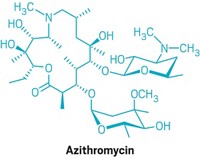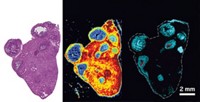Advertisement
Grab your lab coat. Let's get started
Welcome!
Welcome!
Create an account below to get 6 C&EN articles per month, receive newsletters and more - all free.
It seems this is your first time logging in online. Please enter the following information to continue.
As an ACS member you automatically get access to this site. All we need is few more details to create your reading experience.
Not you? Sign in with a different account.
Not you? Sign in with a different account.
ERROR 1
ERROR 1
ERROR 2
ERROR 2
ERROR 2
ERROR 2
ERROR 2
Password and Confirm password must match.
If you have an ACS member number, please enter it here so we can link this account to your membership. (optional)
ERROR 2
ACS values your privacy. By submitting your information, you are gaining access to C&EN and subscribing to our weekly newsletter. We use the information you provide to make your reading experience better, and we will never sell your data to third party members.
Biological Chemistry
Measuring Bacterial Drug Uptake From Outside The Cell
Drug Development: A new method could enable low-dose drug studies by calculating changes in extracellular drug concentration
by Puneet Kollipara
March 26, 2015

As researchers designed a new technique for measuring bacterial uptake of drugs, they—quite literally—had to think outside the box. By measuring tiny changes in the concentrations of drugs left outside of bacterial cells, researchers can infer how much drug the cells have absorbed. The method could be a simple, straightforward way to screen drug candidates at low doses for their ability to penetrate bacteria, without having to look inside the cells themselves (Anal. Chem. 2015, DOI: 10.1021/ac504880r).
When assessing candidate drugs, such as potential antibiotics, researchers like to know how well bacterial cells absorb the compounds. Traditional methods have used fluorescence or radiometric tagging to reveal the compounds’ presence inside cells. The problem is that not all drug candidates can be studied with these techniques, says Ying Zhou of AmberGen, a drug discovery firm in Watertown, Mass. Conventional techniques usually require washing bacterial cells so unabsorbed compound doesn’t distort the measurements. But that carries the risk of rupturing the cells or disturbing the equilibrium of a compound’s internal and external concentrations.
While at AstraZeneca, in Waltham, Mass., Zhou and her colleagues devised a way to measure drug uptake using mass spectrometry. Instead of directly trying to quantify the amount of drug inside the cells, their method seeks to infer it from how the amount left outside of them changes. Advances in mass spectrometry now make that technique sensitive enough to measure these small, clinically relevant concentrations.
To calculate the amount of drug absorbed by cells, the researchers created a series of test solutions. For the first, they mixed the drug and bacteria within a nutrient solution at 37 °C, roughly body temperature. They also placed the drug and bacteria in a nutrient solution cooled with an ice-salt bath to −7 to −4 °C, which is cold enough to prevent the bacteria from sucking up the drug molecules but isn’t frozen thanks to the salt. Finally they added the drug to a control nutrient solution without bacteria at each of the two temperatures.
After 30 to 60 minutes, the researchers centrifuge and drain all the cells from the solutions, then measure the drug concentrations in the remaining liquid with ultra-high-performance liquid chromatography paired with mass spectrometry. At each temperature, the researchers use the control solution to subtract out the effects of drugs that break down or stick to the container surfaces. They then calculate how much drug was taken up by the bacteria by comparing the difference in concentration between the cold and warm solutions.
Zhou and her team demonstrated the technique using two different types of bacteria. In gram-negative Escherichia coli exposed to the antibiotic linezolid, the absorbed amount steadily increased as the dose rose from 5 to 50 ng/mL, which shows that the method can reliably measure drug uptake below the concentrations needed to kill the bacteria. When the researchers tested a strain of E. coli lacking a molecular pump that could spit out the drug, they found, as expected, that that strain always had a lower extracellular concentration, meaning more drug was absorbed.
The team also exposed two strains of the gram-negative bacterium Pseudomonas aeruginosa—one wild-type, the other lacking key uptake channels called porins—to the broad-spectrum antibiotic meropenem. As expected, the external concentrations of the drug were higher with porin-deficient bacteria.
The method holds promise for measuring drug uptake for multiple bacterial species and drug chemistries, Zhou says. Next, the team plans to test their method on gram-positive bacteria. One limitation, Zhou notes, is that this technique cannot determine the fate of the drug molecules that breach the cells’ outermost surfaces.
Laura J. V. Piddock, a microbiologist at the University of Birmingham, in England, praises the researchers’ novel use of mass spectrometry. “I am sure the method will be adopted by those with access to mass spectrometry and further adapted for antibiotics for which there is no other easy way to obtain similar data,” she says.




Join the conversation
Contact the reporter
Submit a Letter to the Editor for publication
Engage with us on Twitter